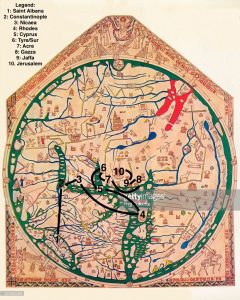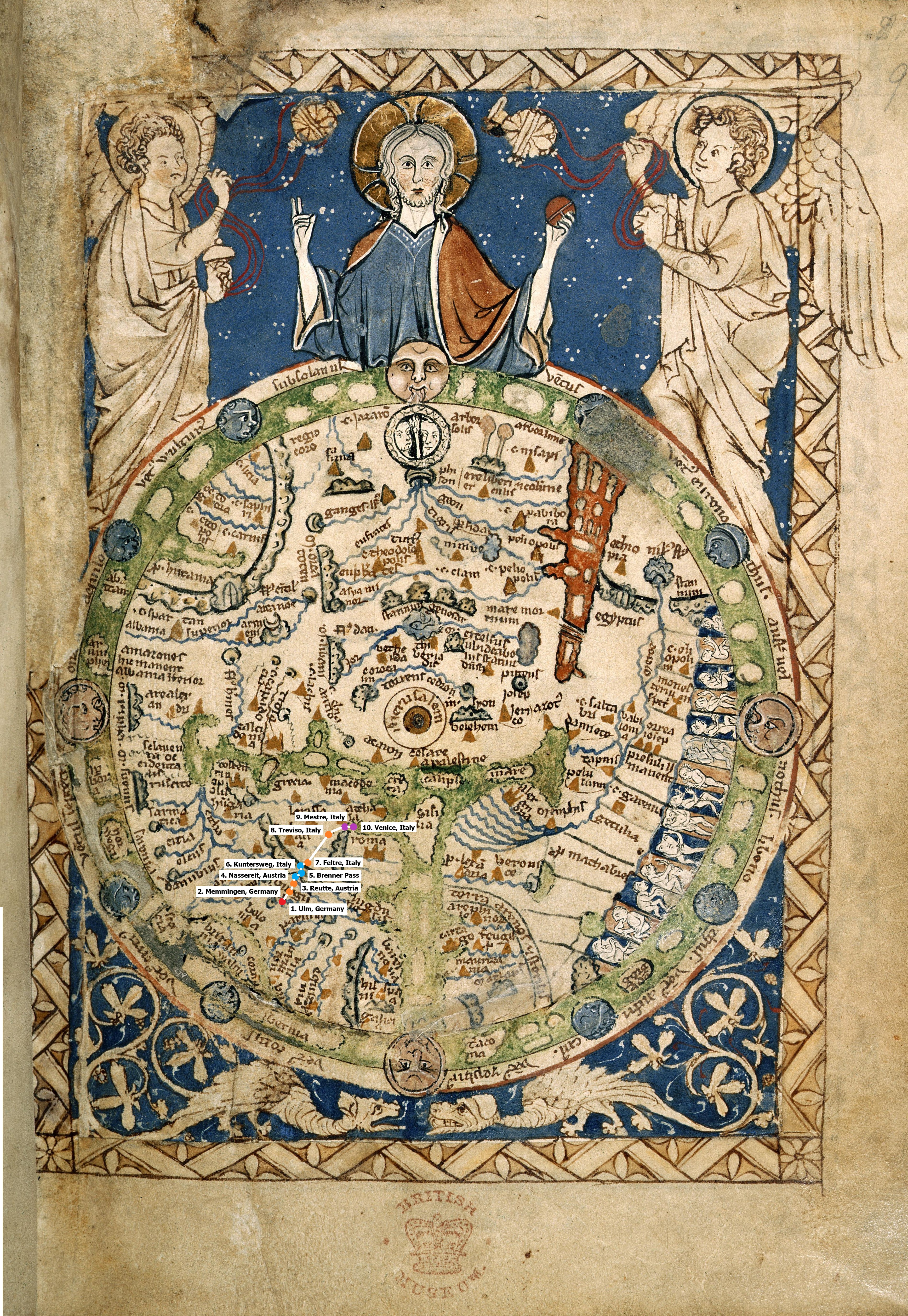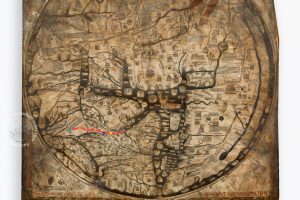
John Mandeville’s Journey on the Hereford Mappa Mundi

John Mandeville’s Journey on the Hereford Mappa Mundi
After Margery Kempe travels to various Holy Sites in Jerusalem, she travels back to Ramleh in modern-day Israel, where she then boards another boat and returns to Venice. Ramleh on the West Bank is 2, 203 miles from Venice. Assuming that most boats around the time traveled at 5 knots, or approximately 5.7 miles per hour, this journey would have taken approximately 16 days, a bit over two weeks. Margery does not speak much about Ramleh, other than remarking that she wishes already “to return again to Jerusalem” (111). The pit stop she describes in Venice is predicated upon the supposition that God has ordered Margery to go to Rome. As a result, she does not focus much on any architecture or cultural points of the city, but focuses on promises God has made to her and deeply describes people who help or hurt her during her endeavors. On the boat ride to Venice, many of Kempe’s companions are ill, but God assures Margery that no one on the journey will die, which ends up being true. God tells Margery that he will ensure that she makes it to Rome safely, and that when He does, Margery must wear white in Rome as she did in England. While in Venice she finds a broken-backed man in his fifties from Ireland whose name is Richard. Margery then recalls that the anchorite Julian of Norwich told her that when her companions have forsaken her, “God will provide a broken-backed man to escort you wherever you want to go” (112). Richard agrees to accompany her for the price of two nobles. Right outside of Venice, the couple stumbled upon two Grey Friars and a lady who had been traveling with Kempe in Jerusalem. The lady had a donkey with a chest containing an image of the Lord that caused Margery many tears whenever she saw it. At Richard’s urging, Margery set out with the lady and Friars, who treated her well and fed her well, and Richard came to bring her cheer every evening and morning.
When God requests Margery wear white after making it safely to Rome, Margery remarks that the “world should wonder at her” but that she would follow God’s command out of love for him (112). From this statement we can deduce that it is strange in medieval culture for a woman of Margery’s status to wear white. Margery is a strange enough case in and of herself for traveling unaccompanied while still being married. However, white clothing in the Middle Ages was also a symbol of purity and innocence. During this time, cloistered virgins were the only members of society who were socially permitted to wear white. The world would likely wonder and be ashamed at Margery for wearing white because she is not a virgin. Having given birth to 14 children, Margery is very far from being considered a virgin. By wearing white, Margery may wish to demonstrate to society that she is a woman of virtue. Wearing all white not only allows Margery to align herself with the holy virgin women she wishes to emulate, but also displays her conversion into a chaste woman to the world. The fact that God proclaims her to wear white gives authority to her action. The Middle Ages are not best known for their sanitation efforts, so white clothing is also impractical for essentially all classes of women. But besides impracticality, it symbolizes a strict adherence to spiritual values. This is made clear within the Bible in Matthew 26, where all the inhabitants of heaven are described as being clothes in white. God giving a command for Margery to wear white allows Margery to emphasize that God believes she is pure and holy and wishes for her to display that to the world. This functions to align Margery not only with virgins on Earth but with the company of heaven. The fact that the command is a dictate from God allows Margery to avoid any legal or societal punishments that may incur for her wearing the color.
Thank you for being understanding of my English Thesis and Political Science Honors thesis deadlines last week and this week. It’s been super busy 🙂


Legend:
Light blue = Ulm
Light green = Memmingen
Pink = Innspruck
Orange = Balzano
Dark blue = Ad Scalam
Yellow = Bassano
Dark green = Treviso
Purple = Venice
Initially, I had some trouble locating my points on the Hereford Mappamundi because the writing isn’t readable on the map. However, once I found out how the countries were laid out, I was able to approximate where they would’ve most likely landed on the Hereford map. I wasn’t able to include all of the points that I plotted on the modern map. Unfortunately, the points became too close together as Fabri’s route entered Italy to plot on the Hereford Mappamundi which could’ve contributed to some of the differences in the shape of Fabri’s route. The first major difference I noticed between the modern map and the Hereford map was that on the Hereford map, Fabri’s route looks much more direct than it does on the modern map. On the modern map, Fabri’s route is less direct and winds through the mountains. Because of the lack of physical features and details on the Hereford map, it was harder to depict the more specific aspects of Fabri’s journey and the route appears to be an almost perfectly straight line from Ulm to Venice. The Hereford map depicts rivers and lakes, with debatable accuracy, but it doesn’t illustrate any mountain ranges. Considering that nearly half of Fabri’s journey takes place within the Alps between Austria and Italy, the lack of mountains contributes to how different his journey looks on the Hereford map compared to the modern GIS map. The lack of mountains also made it more difficult to illustrate an accurate depiction of Fabri’s route and contributed to how straight the route looks on the Hereford map. Additionally, on the Hereford map, Fabri’s route looks horizontal because East is positioned at the top where North would be on a traditional modern map. On the modern map, Fabri’s journey looks vertical, as if his journey is taking him down the map. However, this is mostly due to each map’s differences in orientation, as the modern map is oriented with North towards the top, unlike the Hereford map.
© 2025 Mapping the Global Middle Ages Academic Technology services: GIS | Media Center | Language Exchange
Theme by Anders Noren — Up ↑